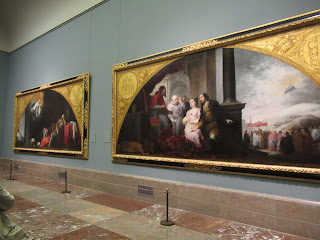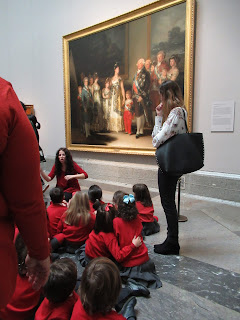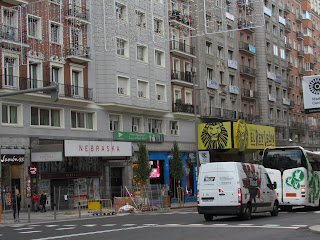We had a fun walk from our hotel through part of downtown Madrid to the Prado Museum, often considered to have the greatest collection of paintings by European masters anywhere in Europe and quite possibly the greatest museum of painting in the world. Some of you may be glad to know that there aren't many pictures from our several hours at the Prado because photography was, once again, not allowed so I was only able to snag a few!
I was intrigued seeing the set of early 12th century murals, purchased by the Spanish government in 1929, that had come from the Church of Vera Cruz in Segovia. We'd been there just a few days previously and hadn't known there had once been murals on the walls of the church built by the Knights Templar. The murals had been transferred to canvas.
The mid-16th century oil painting called The Three Ages was one of the most unsettling piece I'd seen in a while as it showed a dead older woman attempting to pull along a young woman who naturally appeared to be resisting. The dead woman was holding a broken lance, on the lower tip of which was a dead child. The only glimmer of hope was the small crucified Christ looking up toward the sun which represented the celestial Glory. On the bottom, the owl who was the symbol of wisdom until the nineteenth century, was shown looking at the viewer, possibly warning of the consequences of committing a sin.
The Grand Way's first stretch was built in the 1910s as a strip of luxury stores.
That part of the walk was the Spanish version of Broadway with one big theater after another.
Next to the Opera House was Plaza de Isabel II who ruled Spain in the 19th century and was a great patron of the arts. During Franco's dictatorial days, movies at the Real Cinema and others throughout the country were always dubbed in Spanish, making them easier to censor.
According to travel writer Rick Steves' book on Spain, centuries of powerful kings and lots of New World gold funded the Prado which now had an overwhelming 3,000 canvases. Unlike the Thyssen-Bornemisza Museum we'd visited the day before, the Prado wasn't laid our chronologically.
In the Italian Renaissance Gallery, we were fortunate to view Portrait of a Cardinal by Raphael who showed the shy Vatican prelate with a day's growth of beard who seemed to lock eyes with anyone seeing the painting. The three-dimensional world on a two-dimensional canvas showed the painter's talent as a master of realism.
A painting by the Italian painter, Botticelli:
The mid-16th century oil painting called The Three Ages was one of the most unsettling piece I'd seen in a while as it showed a dead older woman attempting to pull along a young woman who naturally appeared to be resisting. The dead woman was holding a broken lance, on the lower tip of which was a dead child. The only glimmer of hope was the small crucified Christ looking up toward the sun which represented the celestial Glory. On the bottom, the owl who was the symbol of wisdom until the nineteenth century, was shown looking at the viewer, possibly warning of the consequences of committing a sin.
In 1507, German artist Albrecht Durer painted the first full-size nude images of Adam and Eve in Northern European art. Steves described them as being like Greek statues with three-dimensional, anatomically correct bodies. "This was a bold humanist proclamation that the body was good, man was good and the things of the world were good." I was glad to have his notes as I wouldn't have gotten that interpretation by myself!
Many of the canvases were often so immense, there were just a few to a gallery.
In the Spanish Masters Gallery, Bartolome Murillo's painting of The Immaculate Conception of Los Venerables showed the 'immaculate' virgin "floating in a sea of Ivory Soap cleanliness, radiating youth and wholesome goodness." She was depicted wearing the usual colors of the Virgin Mary: white for purity and blue for divinity. The escapist work was very popular among the people of Sevilla, Murillo's hometown, who were just recovering from a plague that lasted from 16470-1652.
Many people, myself included, stood agog admiring the copyist who was reproducing a painting in the Spanish Still Life Gallery.
The Prado had a huge collection of paintings by the country's Francisco de Goya. One of his most celebrated paintings was his group portrait, The Family of Charles IV, which also seemed to catch the attention of even the youngest museum goers! This was the best shot I was able to take but take my word for it that Goya himself was also in the painting, depicted on the left standing at the easel, painting the royalty.
Goya's most scandalous work was of Nude Maja, likely modeled by his lover, the Duchess of Alba. I read that a maja was "a trendy, working class girl." Whether the painting was of a duchess or a maja, Goya painted an actual person rather than some mythic Venus which was enough to incur the wrath of the Spanish Inquisition!
What a sweet painting Goya did of these children.
El Greco, an artist born in Greece but whose adopted name is Spanish and means 'The Greek,' made his home in Toledo, just 60 miles from Madrid and the location for our day trip the next day. His paintings were described as "Byzantine icons, drenched in Venetian color and fused in the fires of Spanish mysticism." Okay ...! His painting called The Nobleman with His Hand on His Chest showed the man whose middle fingers were touching. That was apparently El Greco's trademark way of expressing elegance.
The painting of The Execution of Torrijos and his Companions on the Beach at Málaga by Antonio Gisbert Pérez is considered one of the most important 19th-century Spanish history paintings. Torrijos, a leading figure in Spain's constitutional regime during the early years of the 19th century, attempted to return to Spain via Gibraltar. He and his followers were ambushed, however, on the beach and then executed immediately with no trial. The painting was commissioned years later for the museum by the liberal government as an example of defense of freedom against authoritarianism.
Another Spanish artist, Eduardo Rosales, painted Queen Isabella the Catholic dictating her will. The work was described as the masterpiece of 19th century history paintings.
There were of course thousands of other paintings at the Prado but we only saw a smattering over the course of a couple of hours. We thought it better to see some of the masterpieces the museum was internationally famous for and then leave before our eyes totally glazed over even though we knew we could have spent days there!
After being inside for so long, walking to, and then spending time in, the majestic Retiro Park was a very pleasant change. The park, once the exclusive domain of royalty, was opened up to commoners by Charles III who decided to share it with his subjects in the late 18th century.
If we saw one fancy stroller like this, we must have seen a hundred plus of them just in Madrid alone. I don't recall ever seeing such a grand baby carriage either here in the States or back in my native Canada.
I wonder who was daring enough to place a woolen hat atop this statue! Was it a prank, I wondered?
The weather was glorious so we really enjoyed just dawdling and admiring the big lake where people had rented paddle boats.
It was a scream seeing Kermit the Frog of all people there!
A marvelous swing band played tunes we knew well.
We didn't think we'd ever seen as many pansies as we did while exploring the park - they were everywhere and provided a riot of color!
If we'd been moderately lazy, we could have had our pick of segway tours, bike tours or even pedicab tours in the park.
Near the exit to the park was the stunning Puerta de Alcalá, a neo-classical monument regarded as the first modern, post-Roman triumphal arch built in Europe. I was surprised to learn it was therefore older than the Arc de Triomphe in Paris and Brandenburg Gate in Berlin.
Sorry, I can't for the life of me remember what this was but it looked too interesting to simply delete in my opinion.
The grandiose Palacio des Cibeles was built as the post office headquarters in 1910 but later became a cultural center and then City Hall in 2006. It was a simply stunning beginning to our walk along the Gran Via, Madrid's equivalent of New York's Fifth Avenue.
The impressive Banco de Espana:
The real start of the Gran Via walk was the 1920s skyscraper, the landmark gold-domed Metropolis building which celebrated the good times in pre-Civil war Spain.
The Grand Way's first stretch was built in the 1910s as a strip of luxury stores.
I liked the reflection of the old building juxtaposed in the glass of the modern building across the street.
We took a short detour to see and get a snack in what surely must be one of the fanciest Mickey D's anywhere!
The 14-story and 300-foot tall Telefonica skyscraper from the 1920s was the tallest in Spain until the 1950s. Telefonica was Spain's only telephone company through the Franco age; now it is one of the country's few giant blue-chip corporations.
Primark was the first modern department store in the city in the 1920s; we saw branches all over the country.
I bet you've never seen such a beautiful H&M department store before - no surprise because it was built in a grand old theater lobby! It was a treat window shopping there for a few minutes.
A little further up the street was the 1930s stretch, considered to be the 'American Gran Via' to emulate the buildings of Chicago and New York City. A prime example was the round facade and curved windows of the Art Deco Schweppes building which was thought to be radical and innovative in 1933.
It was strange seeing the now shuttered Nebraska Cafeteria restaurant, a reminder that American food was popular well before the advent of fast food.
At the end of the Gran Via was Plaza de Espana with two buildings erected during the Franco era to show he could keep up with the United States. Apparently they only succeeded in reminding people more of Moscow than the USA!
In the square, once thought of as the Rockefeller Plaza of Madrid, was the monument to the famous Spanish writer Cervantes and his central character Don Quixote.
Since we were fairly close, we headed over to the Templo de Debod, a gift donated to Spain from Egypt in 1968 "as a sign of gratitude for the help provided by Spain in saving the Abu Simbel temples.” It seemed rather bizarre to have ancient Egyptian antiquities transplanted to the heart of Madrid, but it was no doubt a great honor as it was one of only four places in the world to have relocated Egyptian buildings from the Nile.
We then rejoined the last part of the self-guided Puerta del Sol walking tour we hadn't had time to finish the day before. In the peaceful Plaza de Oriente, once a car-congested thoroughfare, was the idyllic carousel. I was amused to read a recent Madrid mayor earned the nickname of 'The Mole' for all the digging he did by moving traffic underground!
The bronze statue of Philip IV in front of the Opera House was a a technical feat in its day as the horse stood up on its hind legs.
Another view of the statue with the Royal Palace behind it that we'd also visited yesterday.
More of the ancient tile signs on the corner of buildings that displayed pictures for those who were illiterate hundreds of years ago:
As depicted on the sign, Calle del Arenal was the street of sand as it was the place where it was stockpiled during construction.
As I've mentioned in previous posts, I really get a kick out of street performers, especially if they are particularly good in my opinion. When I dropped some money in this chess player's bucket, he opened his eyes and I could just see a hint of a smile in appreciation!
One of the strongest traditions in Spanish culture is the paseo - people of all generations out together strolling and eyeing everyone else on pedestrianized streets. Calle del Arenal was a perfect place for that! Some of the fancier facades were in the 'eclectic' style which meant a new interest in old styles of the late 19th century.
Janina: You would have loved the Street of the Embroiderers!
Just past that corner was the brick San Gines Church which Steves said meant temptation to most locals as it indicated where people should turn to get their chocolate fix!
At the end of the lane was a neon sign that spelled out Choclateria San Gines, the locals' favorite place for hot chocolate and churros that had been around since 1894. The book stall on the right clinging to the side of the church had been selling books in this same spot since 160.
Zachary: Do you remember my calling you from here when I asked if you wanted a jersey or t-shirt from the official store of Real Madrid, the city's premiere football (soccer to us!) team? I hope you like it half as much as the fun I had picking the gift out for you!
How nice it was to be 'serenaded' at the end of our second walking tour of the day with a mariachi band! I'd always associated the bands with Mexico but perhaps they originated in Spain?
Yes, we'd crammed a lot into our day but, because it was such a wonderful combination of seeing world class art at the Prado, walking in the Retiro Park, eyeing the fascinating architecture along the Gran Via, seeking out the relocated Egyptian temple, 'doing' the paseo on Calle del Arenal, it had been the perfect second day discovering more of Spain's fascinating capital.
Next post: Onto Holy Toledo for the day!
Posted on January 11th, 2019, from suburban Denver.


























































































The reflection of the old building juxtaposed in the glass of the modern building across the street was very interesting, I applaud the photographer. Question is, did you buy/eat chocolate? Janina
ReplyDeleteGlad you liked the reflection photo I took. It reminded me of a very similar one I had taken on our previous trip when we were in Buenos Aires. FYI: We just booked our return flights to BA as it will be our jumping off point for our seven week trip beginning in November to Antarctica, Patagonia and Paraguay.
ReplyDelete